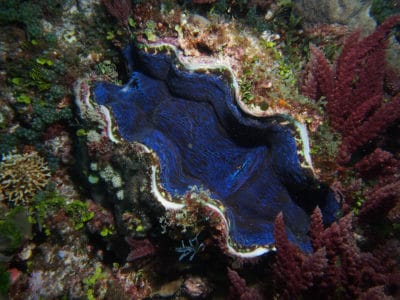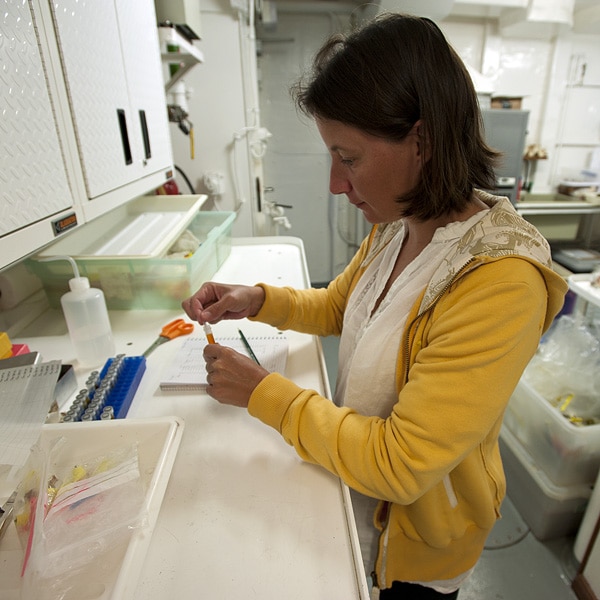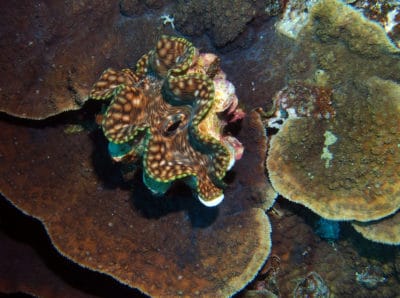South Pacific legends describe giant clams as man-eaters. The largest of all molluscs, giant clams, were once thought to be voracious predators that wait patiently on the seafloor to trap an unsuspecting swimmer. It’s no wonder with a life span of over a century, these “sea monsters” can measure upwards of 1.2 meters (4 feet) and weigh over 200 kg, achieving a size that is presumably large enough to swallow a diver. Yet, these sedentary molluscs are harmless, acquiring most of their nutrition from the symbiotic algae that live within their tissue – just like a coral.

Tridacna deresa, one giant clam species
Once common, giant clams of this size are rarely seen, and many species are threatened with extinction. The largest of the clams, Tridacna gigas, has already disappeared from New Caledonia, and it is now absent from several other locations around the Indo-Pacific. Other clam species are in trouble also, largely because man is eating too many of them. Harvested as a delicacy for both local consumption and as an export commodity, there is a lucrative market for their aductor muscle. To service both the international demand and the expanding human populations throughout the Pacific, giant clam fisheries have greatly expanded resulting in overharvesting.
Giant Clams Species, Overharvesting, and Populations
Being relatively sedentary, giant clams are easy targets. Members of the family also have very specific habitat preferences, which make them even more vulnerable to fishing pressure and overharvesting.
This is where the research Cecilia Fauvelot is conducting during this mission fits in. She is undertaking a population connectivity study of two species of giant clams, Tridacna maxima and Hippopus hippopus. She has been taking small tissue samples from the mantle of the clams throughout New Caledonia to determine how closely related animals are from different populations.
Underwater, she cautiously swims up to a clam, quickly inserting a small wooden plug in the shell to prevent it from closing. She uses special forceps to grab the mantle, and carefully snips off a small piece of tissue. These samples are carefully labeled and preserved for genetic analysis in the laboratory. This process does not harm the giant clam – by following animals over time she has documented regrowth of the tissue.

Cecilia Fauvelot collecting tissue samples from giant clams.
Hippopus is currently one of the most vulnerable of the giant clams in New Caledonia. It prefers very shallow water, and can be collected by wading or snorkeling. During her surveys in Ile des Pins, she found this clam species in a single location – a protected area where no fishing is allowed. In other spots known to once have flourishing populations, all she found was empty shells.
Her research has already revealed the high level of differentiation between populations in New Caledonia. Samples from a protected area on the north coast showed that juveniles were closely related to neighboring adults, with distinct populations occurring within a distance of less than 1 km. She has also learned that stocks found on the east coast of Grande Terre are unrelated to west coast populations. What this means is that overharvesting from one area can cause a population collapse that will take decades to rebound.

Cecilia Fauvelot analyzing tissue samples in the lab to determine how overharvesting has affected clam populations.
Another commercially important clam species, Tridacna maxima, also appears to show high degrees of differentiation among populations. In fact, samples collected across a wide geographic distribution, from Fiji, New Caledonia, French Polynesia and other neighboring countries, indicate that populations from different countries are unrelated, and there is growing evidence that T. maxima may in fact consist of three separate species.
Given the high commercial value of giant clams, and their rapidly shrinking populations, the work that Cecilia is conducting is crucial to the long term survival of these animals. It will help us better understand their life history and can provide key information on approaches to manage these fisheries in a more sustainable way.

Tridacna squamosa
Photos: 1,6 – Andrew Bruckner, 2-5 Ken Marks